Related Research Articles
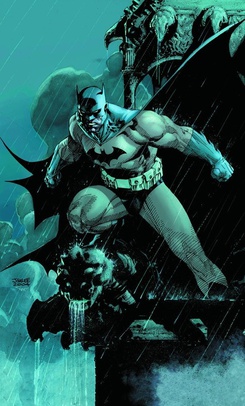
Batman is a superhero who appears in American comic books published by DC Comics. Batman was created by the artist Bob Kane and writer Bill Finger, and debuted in the 27th issue of the comic book Detective Comics on March 30, 1939. In the DC Universe, Batman is the alias of Bruce Wayne, a wealthy American playboy, philanthropist, and industrialist who resides in Gotham City. His origin story features him swearing vengeance against criminals after witnessing the murder of his parents, Thomas and Martha, as a child, a vendetta tempered by the ideal of justice. He trains himself physically and intellectually, crafts a bat-inspired persona, and monitors the Gotham streets at night. Kane, Finger, and other creators accompanied Batman with supporting characters, including his sidekicks Robin and Batgirl; allies Alfred Pennyworth and James Gordon; love interest Catwoman; and foes such as the Penguin, the Riddler, Two-Face, and his archenemy, the Joker.

Gotham City, or simply Gotham, is a fictional city in the Eastern United States that serves as the primary city appearing in American comic books published by DC Comics. It is best known as the home of the superhero Batman and his allies and foes. Created by writer Bill Finger and artist Bob Kane, the city was first identified as Batman's place of residence in Batman #4 and has since been the primary setting for stories featuring the character. In most of its incarnations, Gotham is depicted as one of the most crime-ridden cities in the world.
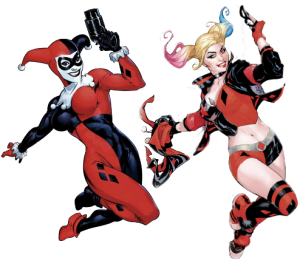
Harley Quinn is a fictional character appearing in American comic books published by DC Comics. She was created by Paul Dini and Bruce Timm for Batman: The Animated Series as a henchwoman for the Joker, and debuted in its 22nd episode, "Joker's Favor", on September 11, 1992. While intended to appear in one episode, Quinn became a recurring character within the DC Animated Universe (DCAU) as the Joker's sidekick and love interest, and was adapted into DC Comics' canon seven years later, beginning with the one-shot Batman: Harley Quinn #1. Quinn's origin story features her as a former psychologist at Gotham City's Arkham Asylum who was manipulated by and fell in love with the Joker, her patient, eventually becoming his accomplice and lover. The character's alias is a play on the stock character Harlequin from the 16th-century Italian theater commedia dell'arte.
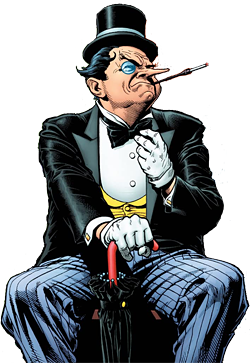
The Penguin is a fictional character appearing in American comic books published by DC Comics, commonly as an adversary of the superhero Batman. The character made his first appearance in Detective Comics #58 and was created by Bob Kane and Bill Finger. The Penguin is one of Batman's most enduring enemies and belongs to the collective of adversaries that make up Batman's rogues gallery. The Penguin has repeatedly been named one of the best Batman villains and one of the greatest villains in comics. Penguin was ranked #51 in IGN's list of the Top 100 Comic Book Villains of All Time.

James W. "Jim" Gordon Sr. is a character appearing in American comic books published by DC Comics, most commonly in association with the superhero Batman. Created by Bill Finger and Bob Kane as an ally of Batman, the character debuted in the first panel of Detective Comics #27, Batman's first appearance, making him the first Batman supporting character ever to be introduced.

Bane is a supervillain appearing in American comic books published by DC Comics. Created by Chuck Dixon and Graham Nolan, the character first appeared in Batman: Vengeance of Bane #1. He has become one of the superhero Batman’s most enduring enemies belonging to the collective of adversaries that make up his rogues gallery.

Hugo Strange is a supervillain appearing in comic books published by DC Comics, commonly as an adversary of the superhero Batman. The character is one of Batman's first recurring villains, and was also one of the first to discover his secret identity. The character first appeared in Detective Comics #36.
The Mad Hatter is a supervillain appearing in comic books published by DC Comics, commonly as an adversary of the superhero Batman. He is modeled after the Hatter from Lewis Carroll's novel Alice's Adventures in Wonderland, a character often called the "Mad Hatter" in adaptations of Carroll. A scientist who invents and uses technological mind control devices to influence and manipulate the minds of his victims, the Mad Hatter is one of Batman's most enduring enemies and belongs to the collective of adversaries that make up Batman's rogues gallery.
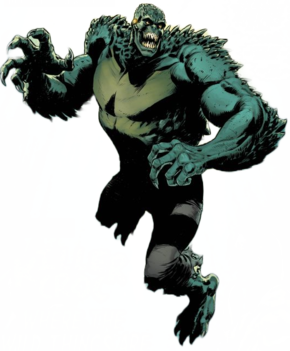
Killer Croc is a supervillain appearing in American comic books published by DC Comics. Created by Gerry Conway, Don Newton and Gene Colan, the character was introduced in Batman #357. He has become one of the most enduring enemies of the superhero Batman and belongs to the collective of adversaries that make up his rogues gallery.

Egghead is a fictional character created for the 1960s Batman television series. Played by Vincent Price, the character was identifiable by his pale bald head and white and yellow suit. He believes himself to be "the world's smartest criminal", and his crimes usually have an egg motif to them; he also includes egg-related puns in his speech and uses various egg-themed weapons. Additionally, Egghead used deductive reasoning to deduce Batman's secret identity.
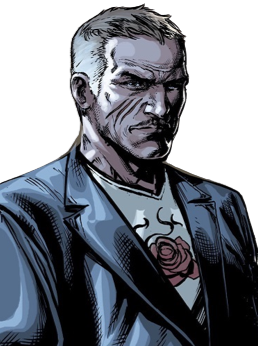
Carmine Falcone is a villain appearing in American comic books published by DC Comics, portrayed as a powerful mob boss, an enemy of Batman, and an acquaintance of the Wayne family. He has also been sometimes depicted as the illegitimate father of Catwoman.
Anthony Zucco is a fictional character appearing in American comic books published by DC Comics. First appearing in Detective Comics #38, Zucco is a mobster responsible for murdering the parents of Dick Grayson, which leads to Grayson's adoption by Bruce Wayne a.k.a. Batman and becoming the latter's sidekick and original Robin and Nightwing.

Salvatore Vincent Maroni is a fictional character appearing in American comic books published by DC Comics, commonly in association with Batman. The substantial character is portrayed as a powerful mob boss and gangster of Italian descent in Gotham City and an enemy of Batman. Maroni is most famous for disfiguring Harvey Dent, setting the stage for the young district attorney's transformation into the supervillain Two-Face.
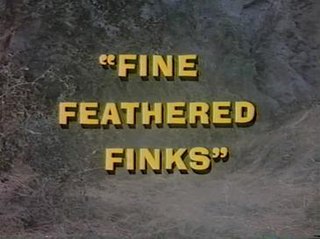
"Fine Feathered Finks" is a first-season episode of Batman, first airing as its third episode on ABC January 19, 1966. It was repeated on August 31, 1966 and May 17, 1967. Burgess Meredith made his debut as The Penguin in this episode.
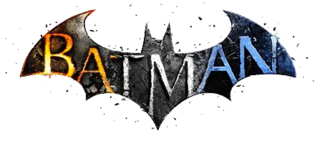
Batman: Arkham is a superhero action-adventure video game series based on the DC Comics character Batman, developed by Rocksteady Studios, WB Games Montréal and Camouflaj, and published originally by Eidos Interactive and currently by Warner Bros. Games. The franchise consists of four main installments and a spin-off, along with four smaller titles for mobile devices, two virtual reality games, tie-in comic books, and an animated film. The continuity established by the games is often referred to as the Arkhamverse.

Batman: Return of the Caped Crusaders is a 2016 American animated superhero film produced by Warner Bros. Animation and distributed by Warner Bros. Pictures. Based on the 1960s Batman TV series, the film stars the voices of Adam West, Burt Ward, and Julie Newmar reprising their roles of Batman, Robin, and Catwoman from the series. In the film, Batman and Robin set out to defeat the Joker, the Penguin, the Riddler, and Catwoman, who have teamed up. Matters are further complicated when Batman gradually becomes more hostile.

Batman vs. Two-Face is a 2017 American animated direct-to-video superhero film produced by Warner Bros. Animation and distributed by Warner Bros. Home Entertainment and a direct sequel to Batman: Return of the Caped Crusaders. It premiered at the New York Comic Con on October 8, 2017, was released digitally on October 10, and on DVD and Blu-ray on October 17. Based on the 1960s Batman television series, the film stars Adam West, Burt Ward and Julie Newmar reprising their roles of Batman, Robin and Catwoman from the series. It was West's final performance as Batman and was released posthumously.

The character Two-Face was created by Bob Kane and first appeared in Detective Comics #66. However, he did not appear outside comics until half a century later in Batman: The Animated Series. Two-Face has since been substantially adapted from the comics into various forms of media, such as feature films, television series and video games. Two-Face has been voiced by Richard Moll in the DC Animated Universe, Troy Baker in the Batman: Arkham series, Billy Dee Williams in The Lego Batman Movie, and William Shatner in Batman vs. Two-Face. His live-action portrayals include Billy Dee Williams in Batman (1989), Tommy Lee Jones in Batman Forever, Aaron Eckhart in The Dark Knight, Harry Lawtey in Joker: Folie à Deux, and Nicholas D'Agosto in the television series Gotham. In 2009, Two-Face was ranked #12 on IGN's list of the Top 100 Comic Book Villains of All Time.
References
- ↑ Batman '66 #3